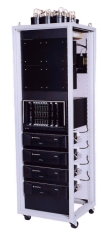


 |
Trunking Communications Overview
For organizations where instant, effective and private communications are a vital part of everyday operation, a trunked two-way radio system provides the coverage, channel efficiency, security and flexibility needed.
Simply put, trunking permits a large number of users to share a relatively small number of communication paths - or trunks. Commercial telephone communication is a wireline version of trunking. This sharing of communication paths is managed automatically by a computer. Channel selections and other decisions normally made by the radio user are made by the central controller, a computerized switch. Channel assignment is automatic and completely transparent to the individual users.
Trunking offers many benefits, including faster system access, better channel efficiency, more user privacy and the flexibility to expand. Because of its flexibility, a trunked system can expand along with your operation, to accommodate a growing number of users and restructuring of talkgroups. And it can be continuously upgraded with software.
With trunking large quantities of users will no longer need to share a common RF channel and compete for air time. In addition, users won't need to monitor a channel in order to make a call on their own.
PassPort Trunking protocol
PassPort is a trunking protocol developed by Trident Micro Systems that provides wide-area coverage and offers users and system owners several enhanced features, including:
- Seamless roaming with automatic registration and de-registration between sites
- Piracy and cloning protection through Electronic Serial Numbers
